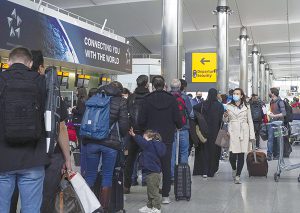The summer travel season is picking up — and so are the airport horror stories.
Long lines, delays and cancellations have been particularly rampant in the UK, Europe and Canada in recent weeks, but the US has certainly seen its fair share of travel blowups. So far this year, about 20% of the flights from US carriers have been delayed by an average of 48 minutes, according to data from FlightAware. That’s up from 12% of flights during the same stretch last year and about 16% in 2019. US carriers canceled more than 2,500 flights over the busy Memorial Day travel period, FlightAware data show. A substantial portion of those came from Delta Air Lines Inc., which warned of cutbacks just days before the holiday weekend started and said it would cull 100 flights a day between July 1 and Aug. 7 to improve operational reliability.
Delta is far from the only airline struggling to align its flying capabilities with a resurgence in demand. Covid continues to fuel increased absences among an already thin staff. There simply aren’t enough pilots to go around. There are fewer planes than airlines would like, too, because Boeing Co. is struggling to deliver 737 Max jets amid supply chain challenges and is prevented from handing over 787 Dreamliners while the Federal Aviation Administration reviews changes to its production processes. That leaves a thin cushion to absorb unavoidable disruptions such as weather. The preemptive cuts to flying schedules are an attempt to ensure more customers will actually get from point A to point B. The large US carriers were targeting about 91% of their pre-pandemic capacity for the second quarter as of the end of May, down from 105% as of late January, according to an analysis from Cowen & Co. analyst Helane Becker. Even with the efforts to rebalance their schedules, it’s likely to be a “disastrous summer†for airline travel, Becker said this week in an interview with Bloomberg TV.
There’s been plenty of hand-wringing about the impact that ticket price inflation might have on consumers’ willingness to travel. Data released Friday from the Bureau of Labor Statistics showed airline fares continued to climb in May after surging by the most on record in April. Ticket prices have now topped the previous peaks of 2013 and 2014 on a seasonally adjusted basis. Airline executives are unanimous in insisting there’s been no measurable effect on bookings. If anything, the opposite is true: Demand for airline travel is “amazingly strong†and is reaching “levels I’ve never seen in my entire career,†Alaska Air Group Inc. Chief Executive Officer Ben Minicucci, who has worked in the industry for about 25 years, said. —Bloomberg
 The Gulf Time Newspaper One of the finest business newspapers in the UAE brought to you by our professional writers and editors.
The Gulf Time Newspaper One of the finest business newspapers in the UAE brought to you by our professional writers and editors.
